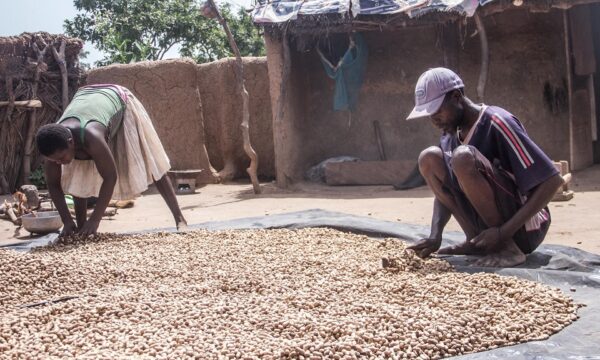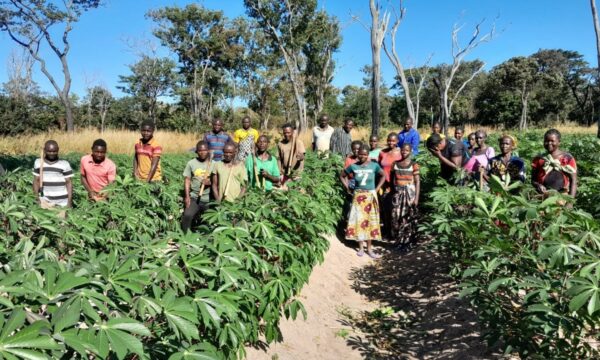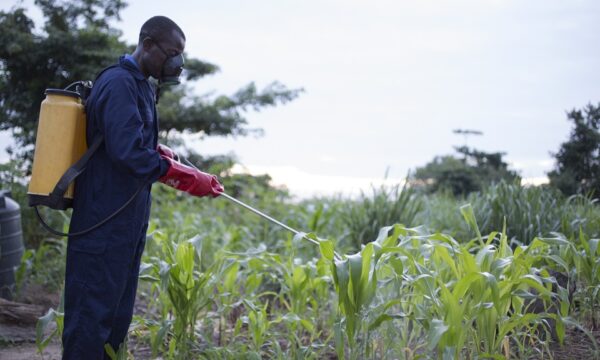
Cassava is a staple food for millions but is susceptible to viruses that make it unpalatable © Seth Anderson (CC BY SA license)
One of the worst diseases of the tuber crop, cassava, in sub-Saharan Africa is Cassava brown streak disease (CBSD). Since its resurgence in East Africa in recent years, it is now spreading to Central and Western Africa. The other major disease of cassava in this region, Cassava mosaic disease (CMD), can also cause widespread damage to the crop, however there already CMD-resistant varieties of cassava available. Until now, very little natural resistance to CBSD has been found. Plant scientists at the Swiss Federal Institute of Technology (ETH) Zurich have combined natural resistance to CMD with modifications of the cassava genome to develop a variety of cassava resistant to both CBSD and CMD that can be grown in Africa. As cassava is a staple food to millions of people, this new variety has the potential to halt the spread of the disease and prevent famine from crop losses.

(A) Cassava tubers infected with CBSV showing brown lesions (B) Modified, virus-resistant cassava infected with CBSV showing no symptoms of the virus (Vanderschuren et al 2012, CC BY license)
There are two virus species that together cause Cassava brown streak disease. These are Cassava brown streak virus (CBSV) and Ugandan cassava brown streak virus (UCBSV). The viruses cause the inside of the cassava roots to turn brown, making them inedible. Sometimes it is not obvious that the crop has been affected until it is harvested and the tubers are inspected.
The scientists at ETH Zurich developed the new cassava variety by altering the genetic make-up of a Nigerian variety of cassava (known as ‘Oko-iyawo’), which is naturally resistant to CMD. This led to a variety with resistance to both damaging diseases. The altered gene codes for small interfering RNA molecules (siRNA), which plants produce naturally once they have been infected with the virus. The siRNA attaches to the RNA of the virus, stopping it from multiplying within the plant. By altering the gene that causes the plants to produce the siRNA molecules before they are infected, a defence is built up. If the genetically modified cassava plants are infected with CBSV and/or UCBSV, the siRNA molecules bind to the virus genome and it never multiplies.
This new variety of cassava has proved successful at resisting CBSD and CMD in glasshouse trials. The aim now is to test it in the field in Africa to ensure that its virus resistance endures.
References:
ChannelS Television (2012). Scientists develops new Nigerian cassava ChannelS Television
Rüegg, P. (2012). New African cassava resists devastating viruses ETH Life
Vanderschuren H, Moreno I, Anjanappa RB, Zainuddin IM, & Gruissem W (2012). Exploiting the Combination of Natural and Genetically Engineered Resistance to Cassava Mosaic and Cassava Brown Streak Viruses Impacting Cassava Production in Africa. PLoS ONE, 7 (9) DOI: 10.1371/journal.pone.0045277
4 Comments
Leave a Reply
Related News & Blogs
CABI’s communications campaign aids the fight against Cassava Brown Streak Disease in Zambia
CABI Zambia has recently shared evidence on the impact of its communication campaign on Cassava Brown Streak Disease. The assessment finds that the campaign activities played a pivotal role in the fight against CBSD at both local and national levels. …
14 January 2024





[…] One of the worst diseases of the tuber crop, cassava, in sub-Saharan Africa is Cassava brown streak disease (CBSD). Since its resurgence in East Africa in recent years, it is now spreading to Centr… […]
[…] click here to view:Cassava virus resistance breakthrough for Africa « The Plantwise Blog […]
[…] Cassava virus resistance breakthrough for Africa (plantwise.org) […]
[…] made in the intensification of cassava production in Africa. Since my colleague, Abigail Rumsey, reported on the resurgence of this disease in East Africa, and spread to Central and Western Africa, there are […]